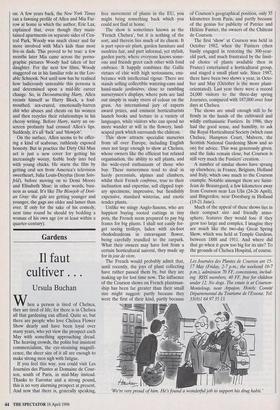Gardens
Il faut
cultiver . . .
Ursula Buchan
When a person is tired of Chelsea, they are tired of life; for there is in Chelsea all that gardening can afford. Quite so, but there are people who love Chelsea Flower Show dearly and have been loyal over many years, who yet view the prospect each May with something approaching dread. The heaving crowds, the polite but insistent commercialism, the eye-straining magnifi- cence, the sheer size of it all are enough to make strong men sigh with fatigue.
If you feel this way, you could visit Les Journees des Plantes at Domaine de Cour- son, south of Paris, in mid-May instead. Thanks to Eurostar and a strong pound, this is no very alarming prospect at present. And now that there is, generally speaking, free movement of plants in the EU, you might bring something back which you could not find at home.
The show is sometimes known as the `French Chelsea', but it is nothing of the sort, and therein lies much of its charm. It is part open-air plant, garden furniture and sundries fair, and part informal, yet stylish, garden party, where everyone knows some- one and friends greet each other with fond embrace. It happily combines the Gallic virtues of chic with high seriousness, exu- berance with intellectual rigour. There are stands selling collectible watering-cans and hand-made jardinieres, close to rambling nurserymen's displays, where pots are laid out simply in snaky rivers of colour on the grass. An international jury of experts award prizes, and eminent horticulturists launch books and lecture in a variety of languages, while visitors who can spend no more wander at will in the flowery, land- scaped park which surrounds the château.
This show attracts specialist nurseries from all over Europe, including English ones not large enough to show at Chelsea, whose owners like the efficient but relaxed organisation, the ability to sell plants, and the wide-eyed enthusiasm of those who buy. These nurserymen tend to deal in hardy perennials, alpines and climbers, whilst their French confreres, true to their inclination and expertise, sell clipped topi- ary specimens, impressive, but fiendishly expensive, standard wisterias, and exotic tender plants.
Unlike we stingy Anglo-Saxons, who are happiest buying rooted cuttings in tiny pots, the French seem prepared to pay big francs for big plants. I shall not easily for- get seeing trolleys, laden with six-foot rhododendrons in extravagant flower, being carefully trundled to the carpark. What their owners may have lost from a certain horticultural naiveté, they made up for in joie de vivre.
The French would probably admit that, until recently, the joys of plant collecting have rather passed them by, but they are making up for lost time now. The influence of the Courson shows on French plantman- ship has been far greater than their small size might suggest: partly because they were the first of their kind, partly because of Courson's geographical position, only 35 kilometres from Paris, and partly because of the genius for publicity of Patrice and Helene Fustier, the owners of the Château de Courson.
The first 'show' at Courson was held in October 1982, when the Fustiers (then busily engaged in restoring the 300-year- old park, and much frustrated by the limit- ed choice of plants available then in France) entertained a horticultural group, and staged a small plant sale. Since 1987, there have been two shows a year, in Octo- ber and May (October is the more plant- orientated). Last year there were a record 24,000 visitors to the three-day spring Journees, compared with 187,000 over four days at Chelsea.
The shows are small enough still to be firmly in the hands of the cultivated and wildly enthusiastic Fustiers. In 1986, they had the good sense, and humility, to ask the Royal Horticultural Society (which runs Chelsea, Hampton Court, Malvern, the Scottish National Gardening Show and so on) for advice. This was generously given, and the links remain close, but Courson is still very much the Fustiers' creation.
A number of similar shows have sprung up elsewhere, in France, Belgium, Holland and Italy, which owe much to the Courson example. Notable amongst them are Saint- Jean de Beauregard, a few kilometres away from Courson near Les Ulis (24-26 April), and Bingerden, near Doesburg in Holland (19-21 June).
Much of the appeal of these shows lies in their compact size and friendly atmo- sphere, features they would lose if they grew too large and complex. I imagine they are much like the two-day Great Spring Show, which was held at Temple Gardens, between 1888 and 1911. And where did that go when it grew too big for its site? To the grounds of Chelsea Hospital, of course.
Les Joumees des Plantes de Courson are 15- 17 May (Friday, 2-7 p.m.; the weekend 10-7 p.m.), admission 70 FF, concessions, includ- ing RHS members, 40 FF, free for children under 12. No dogs. The estate is at Courson- Monteloup, near Arpajon. Hotels: Comite Departemental du Tourisme de l'Essone. Tel: 33(0)1 64 97 35 13.
`We're very proud of him. He's found a wonderful job to support his drug habit.'


























































 Previous page
Previous page